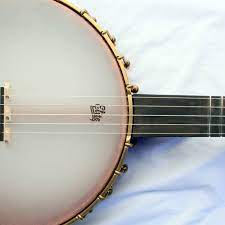If you're interested in learning how to play the banjo, one of the first things you need to know is how many strings it has. While there are different types of banjos, each with its own unique string configuration, the most common type of banjo has five strings. In this blog post, we'll explore the different types of banjos and their respective string configurations.
The 5-String Banjo
The 5-string banjo is the most common type of banjo and is often used in bluegrass and country music. It has four long strings and one short string that is higher pitched. The four long strings are usually tuned to the notes G, D, A, and E, with the highest-pitched string tuned to a high G note. This tuning is known as "open G" tuning.
Open G Tuning
Open G tuning is the most common tuning for the 5-string banjo. It's called "open G" because when you strum all the open strings, it produces a G chord. This tuning allows for a wide range of chord voicings and melodic possibilities.
Other Tunings
While open G tuning is the most common, there are other tunings that banjo players use, such as open D, open A, and double C. These alternative tunings can produce different tonalities and are often used in different styles of music.
The 4-String Banjo
The 4-string banjo, also known as the tenor banjo, was popularized in the early 1900s and was commonly used in jazz and traditional Irish music. It has four strings that are usually tuned to either C, G, D, A or D, G, B, E.
Tenor Banjo Tuning
The tenor banjo is most commonly tuned to C, G, D, A, which is the same tuning as the top four strings of a guitar. This tuning allows for easy chord voicing and is often used in jazz and Dixieland music.
Plectrum Banjo Tuning
The plectrum banjo is similar to the tenor banjo but is typically tuned to D, G, B, E, which is the same tuning as the top four strings of a guitar with the lowest string omitted. This tuning allows for a wider range of chord voicings and is often used in traditional Irish music.
The 6-String Banjo
The 6-string banjo, also known as the guitar banjo, is a hybrid instrument that combines the characteristics of a guitar and a banjo. It has six strings that are usually tuned to the same notes as the top six strings of a guitar, which are E, A, D, G, B, and E.
Guitar Banjo Tuning
The tuning for the guitar banjo is usually the same as a guitar, which is E, A, D, G, B, and E. This makes it easy for guitarists to transition to playing the banjo without having to learn new tuning patterns.
Applications of the Guitar Banjo
The guitar banjo is often used in genres such as country, bluegrass, and folk music. It provides a unique sound that blends the tonal qualities of a guitar with the percussive nature of a banjo.
The 8-String Banjo
The 8-string banjo, also known as the octave banjo or mandolin banjo, is a less common type of banjo. It has eight strings that are usually tuned in pairs to the same notes, but one octave apart. The most common tuning for the 8-string banjo is G, D, A, E.
Octave Banjo Tuning
The octave banjo is usually tuned in pairs, with each pair of strings tuned to the same note, but one octave apart. This tuning produces a unique sound that can add depth and richness to a musical arrangement.
Applications of the Octave Banjo
The octave banjo is often used in genres such as Celtic and folk music. It provides a unique sound that can add a melodic and harmonic richness to musical arrangements.
Conclusion
Understanding the number of strings and tuning configurations for different types of banjos is an essential first step in learning how to play this versatile instrument. Whether you're interested in playing bluegrass, jazz, or Celtic music, there's a type of banjo that can help you achieve your musical goals. By exploring the different types of banjos and their respective string configurations, you can choose the right banjo for your musical interests and start playing this unique and beautiful instrument today.
In conclusion, the number of strings on a banjo depends on the type of banjo you have. The most common type of banjo is the 5-string banjo, which has five strings in an open G tuning. The 4-string banjo, also known as the tenor banjo or plectrum banjo, has four strings and is usually tuned to either C, G, D, A or D, G, B, E. Understanding the different types of banjos and their respective string configurations is an important first step in learning how to play the banjo.
FAQs
- How many strings does a traditional banjo have?
A traditional banjo typically has 5 strings. These strings are usually tuned to the notes G, D, G, B, and D.
- Can a banjo have more than 5 strings?
Yes, there are banjos that have more than 5 strings. Some banjos have 6 strings, while others have 8 or even 10 strings.
- What is a 6-string banjo?
A 6-string banjo, also known as a guitar banjo, is a hybrid instrument that combines the characteristics of a guitar and a banjo. It has six strings that are usually tuned to the same notes as the top six strings of a guitar, which are E, A, D, G, B, and E.
- What is an 8-string banjo?
An 8-string banjo, also known as an octave banjo or mandolin banjo, is a type of banjo that has eight strings that are usually tuned in pairs to the same notes, but one octave apart. The most common tuning for the 8-string banjo is G, D, A, E.
- What are the advantages of having more strings on a banjo?
Having more strings on a banjo can provide additional range and versatility in terms of the notes that can be played. It can also allow for more complex chord progressions and arrangements.
- Can a banjo with more strings be used to play traditional banjo music?
Yes, banjos with more strings can be used to play traditional banjo music. However, it may require some adjustments to the playing style and technique.
- Are there any downsides to having more strings on a banjo?
One potential downside of having more strings on a banjo is that it can make the instrument more difficult to play and may require more practice to master. Additionally, banjos with more strings can be more expensive than traditional 5-string banjos.

